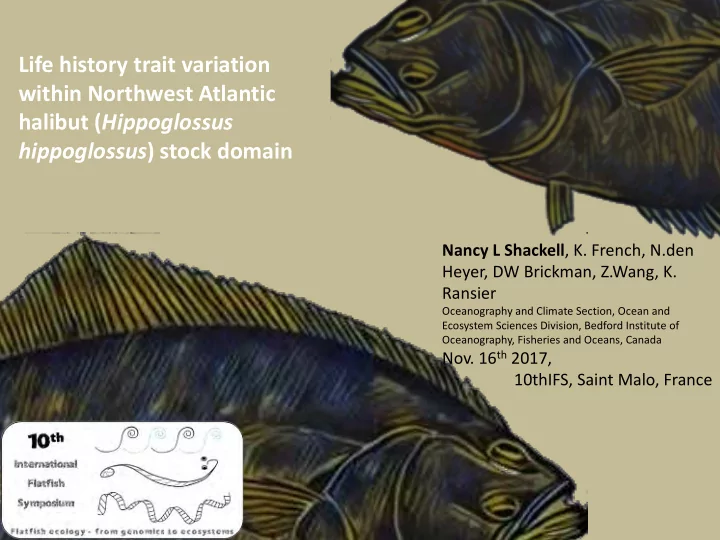

Life history trait variation within Northwest Atlantic halibut ( Hippoglossus hippoglossus ) stock domain Nancy L Shackell , K. French, N.den Heyer, DW Brickman, Z.Wang, K. Ransier Oceanography and Climate Section, Ocean and Ecosystem Sciences Division, Bedford Institute of Oceanography, Fisheries and Oceans, Canada Nov. 16 th 2017, 10thIFS, Saint Malo, France
Managed as two separate stocks: Gulf of Saint Lawrence Scotian Shelf & Southern Grand Banks (Newfoundland) since 1988 Newfoundland 3L Overseas France 5Y Both are experiencing a period of high juvenile recruitment
2015 Value of Commercial 2015 Value of Commercial Groundfish Groundfish Canada = $362 Million Atlantic Canada = $216 Million Greenland halibut Greenland halibut Atantic halibut Atlantic halibut Pacific halibut Haddock Flatfishes Atlantic Cod Redfish spp. Redfish spp. Haddock Cod Flatfishes Other Other 30 Total Legal Spawning 25 Biomass, 1000t 20 Halibut survey biomass index 15 10 5 0 1970 1976 1982 1988 1994 2000 2006 2012 Year 3
Atlantic halibut research Some of what we know… Some of the Knowledge Gap History of Overfishing Migration routes Stock Structure?? Spawning Transboundary stock, dichotomous Areas views: Possibility of smaller scale resident populations Shackell et al. 2016. ICES J Mar Sci Nursery Areas Sietz et al. 2016. J. Northw. Atl. Fish. Sci
(Nancy Shackell, Nell den Heyer, Kiyomi French/DFO, Canada) Q: Are the following consistent with current stock unit domain? Size of Juvenile Connectivity Mature female Habitat ~ Adult Life history trait Current=2000km; Residents: 6 km Estimated=250km Winter Migration: <250km landings A: Nope… Next Step: add Spatial Management to Framework Assessment Genetic landscape Range expansion/secondary role of closed areas (in progress) Shackell et al. 2016 ICESJMar, Boudreau et al. 2017 Ecol&Evol 5 French et al. in press. Fish Bull.
Q: Is there spatial variation in Growth and/or Length at Maturity?
Commonly observed life history strategy in ectotherms Grow slower Larger size/age at maturity Grow faster Smaller size/age at maturity Size Life History tradeoff • Growth decreases as energy is allocated to reproduction Selection acts on maximizing • reproductive output Slow growers make up fecundity diffs • by larger size (from Berrigan and Charnov, 1994) Age
How might life history traits vary across management unit? Trumble et al. 1993, Bowering et al 1986 FEMALE LM50%=119cm FEMALE LM50%=103cm Halibut may exhibit a geographic gradient in length at maturity (Sigourney et al. 2006),
Expectations Halibut will exhibit slower growth and larger length at maturity in the north grading to faster growth and smaller length at maturity in the south, in response to variability in ambient bottom water temperatures. Grow slower Larger size/age at maturity Size Grow faster Smaller size/age at maturity Age
Joint Industry DFO/Halibut Longline Survey • Tagging data to estimate Growth Rate – Selected all fish that were re-captured in the same NAFO where they were initially tagged and at liberty for >50 days. – Assumed growth followed a von Bertalanffy function and used the least presumptive method of Gulland and Holt (1959) for small sample sizes • Observer data to estimate Length at Maturity – Logistic regression
Growth Rate
Predicted annual growth rate for both sexes at 90 cm. Values are marginal means, controlling for length, to account for unbalanced design SOUTH NORTH Both males and females grow Fastest in southern area and at same rate elsewhere SOUTH NORTH
Length at Maturity
NORTH SOUTH
SOUTH NORTH FEMALE 119cm FEMALE 103cm At this stage, South: growing faster and • maturing at smaller sizes than more northerly regions consistent with published • estimates BUT—no GRADIENT • SOUTH NORTH
Temperature Trends Most optimal habitat corresponds with warmer waters •
Are Life history traits related to growing conditions? Growing degree days (GDD) as is used in agriculture and fish (Neuheimer et al. 2008). GDD =number of days (2001-2015) multiplied by a daily temperature . threshold (3°C). GDD was matched to each sample
http://www.photolib.noaa.gov/700s/figb0010.jpg FISHING HISTORY • <1700’s-early 1800’s Halibut=NUISANCE in US Cod fishery (not easy to salt) Train system improves in early 1800s providing …not so heavily fished easier access to Ice US fishermen predominate. Canadians not in until 1900s Commercial fresh fish on ice 1836 L overfished 1880= L Collapse -Head to Canada under Treaty of Paris (1783) By 1850 19 L overfished By 1850 L overfished PS Longlines select larger fish
Summary Common tradeoff of growth and size at • maturity is reflected in our results. Fast growth and smaller length at maturity • were estimated from separate individuals all sampled within division 4X (and the contrary in northerly divisions) Division estimates of growth and length at • maturity are comparable to literature: (Trumble et al 1993, Sigourney et al 2006, Armsworthy and Campana, 2010, Beaty and Chen 2017) • Working hypothesis (until more data accrues): 4X is different from all other northerly regions. Our combined work suggests: 2-3 substocks, where one area is currently being “subsidized/rescued” by another.
• Thank you/Merci!
Length at Maturity (LM50%) c Fit logistic regressions to estimate L50%
Canadian and Foreign Landings Some of this Greenland halibut Scotian Shelf & Gulf of St. Lawrence South and West Newfoundland 24
Connectivity -Coherent temporal patterns on average 250km (smaller than current domain ~2000km) Persistent areas But …those in sNF disappeared
Unit Stock …all of this affects all of that-> Adapted from http://www.iiasa.ac.at/web/scientificUpdate/2013/researchProgram/EvolutionandEcology/EvolutionaryConsumption.html
Fully saturated generalized linear model, ~average (Length at Recapture and Length at Release), NAFO and Sex as factors
Fishing Before and After Moratorium Landings of cod, halibut and other groundfish have decreased dramatically since the cod moratorium (1992-1994)
ASSUMPTION: One Stock from southern Grand Banks to 40°N in USA (~2000km) Initial investigation had climate change focus—highly relevant in warming waters. Halibut from 1965-2013
WHY?—Climate change? too hot in US? Work work work => (no)
Recommend
More recommend